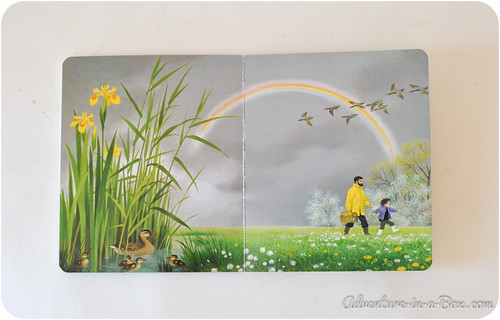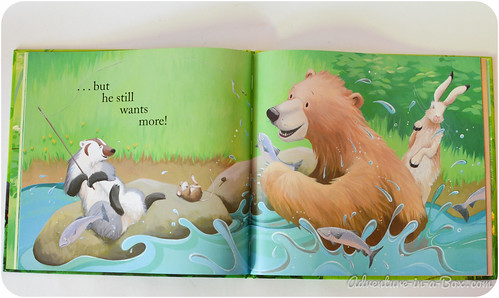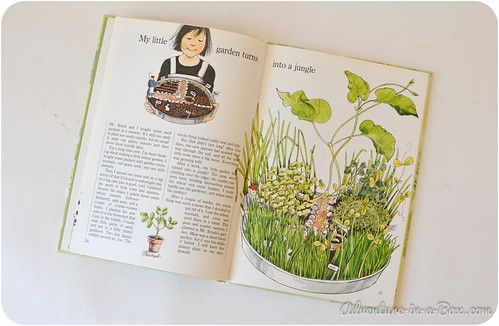This year we had a long winter, and even now, as I show grass and leaves on the pictures to Budster, I wonder whether he remembers how it should look when the warm weather finally settles. Time goes slowly for children, and if we think that the winter was long, for him it is probably all he remembers. That’s why we are so happy to bathe in the sun, spending half a day outside, and when we are inside, we read books about spring.
Spring is a small sturdy book by the German writer and illustrator Gerda Muller. It has no words, but pictures the pleasures of spring that children can enjoy; feeding farm animals, watching baby birds, going for walks in the woods, looking at rainbows, painting eggs, and planting their own small gardens. All of these outdoor activities have a peaceful, old-fashioned feel to them, so Muller’s book is a good evening read for parents and small children to review their spring day or make plans for the next one.
This book is one of a series, including Summer, Autumn
and Winter Board Book
. I would like to have the rest of them for our collection, in the future.
Harvey the Gardener by Lars Klinting is an engaging and encouraging manual for young gardeners on how to grow their own beans. Harvey is a beaver, and he comes all the way from Sweden, where he has been famous since the 90s. He and his friend Chip are good at explaining to children in a fun and simple way how to grow plants, bake bread or make their own toolbox. The books are filled with beautiful and detailed illustrations, and I can see how they can become the first steps in a lot of family projects.
Bear Wants More has already made an appearance in my blog. The brilliance of the spring forest, pictured by Jane Chapman, with the poetic escapades of the furry crew, familiar from other books (Bear Snores On
, Bear Stays Up for Christmas
, etc.), makes this book a perfect choice for a good spring-related reading in our house.
In the Town All Year Round by Rotraut Susanne Berner is a German book that can sometimes be published in four volumes, featuring each season separately, but our edition happens to have all seasons in one. Readers can flip through winter, spring, summer and autumn at once or concentrate on one at a time. The later is probably better, because the illustrations are swarming with characters, events and details. It is impossible for a kid to see all the plots at once – this is why children usually pick up a couple of favourite characters and follow them from one page to the next. It is wordless, except for the page in the beginning of each season that lists some of the important characters and what is happening with them. For instance, the chapter Spring starts with pictures of two cats and a small note: Cassie follows Lucky everywhere. Can you guess what will happen in the Summer chapter? ;-)
Even though the book is wordless, the potential for learning is great for different ages. Young toddlers like to find familiar objects on the pages and show them to adults. “Car! Bicycle! Garbage truck!” exclaims Budster, while finding different vehicles. With older children, stories and plots unravel – first, told by parents, then by children themselves.
Listen, Listen by Phillis Gershator was Budster’s unconditional favourite when he was one year old. He wanted to listen to this book several times a day, and I never grew tired of reading it either. The warm, patinaed paintings by Alison Jay made the book a delight to look at as well. The style of illustrations in Listen, Listen is similar to a wimmelbook; readers watch as the same scene changes with the weather. While the book’s narration tends to focus on the sounds that can be heard throughout the year, the inquisitive child will learn plenty of seasonal activities from the illustrations. Lively scenes accompanied by a myriad of sound effects make an ideal combination for a one-year-old. The book is buzzing and whirring from the first page full of bugs and beetles to the last, where we reunite with the same insects, as the yearly cycle completes itself.
Listen, listen… What’s that sound? Insects singing all around.
Chirp, chirp, churr, churr, buzz, buzz, whirr, whirr.
Leaves rustle, hammocks sway. Splish, splash, children play.
Clouds drift, dogs run. Sizzle, sizzle, summer sun.
Seeing a plump, busy squirrel in the book always made Budster laugh; they were old friends he liked watching through the window. In the end of the book there are four additional pages with animals, plants and objects to find. After finding them on the pictures, it would be interesting to go outside and look for them around the neighbourhood. Here are suggestions for spring: a bluebell, a daffodil, a tulip, a sparrow, a chick, a rabbit, a duckling, a frog, a rainbow, a leaf. We would have some difficulties with chicks and ducklings in our immediate surrounding, but the rest would be easy. What about you?
There is also a direct message in the end of the book to listen for sounds around you. With older children this book can become an invitation to a fun exercise of creating your own onomatopoeic words. “How does a cardinal bird sounds? How does a wind chime sound? How does a garden hose sound?”
Finally, Linnea’s Almanac by Christina Bjork and Lena Anderson is a Swedish book I would normally recommend for older children (5+), however we really like looking at the pictures in this book, and there are many simple crafts and activities that parents could repeat with young children,
“Hi! My name is Linnea,” the book begins. “I am named after the ‘linnaea’, a little pink woodland flower. I’m no woodland flower, though – I’m an asphalt flower. I live right in the middle of the city, but I love plants and flowers and everything that grows. So a city isn’t such a great place for someone like me, right? Wrong. All over my room, things are growing.”
So, another great thing about this book is you can live in a city, like Linnea, to do all the exciting biology-related experiments and even grow your own garden.
The book starts with January, but we can skip to spring months. What is Linnea doing? In March she is playing “Poohsticks” and learning about the Latin names of flowers, watching blackbirds and putting freshly cut branches into a jar of water to see small leaves. In April she is planting her windowsill garden and watching it turn into a jungle, then she is learning about simple outdoors games from her elderly neighbour. In May, Linnea and her neighbour are using an old flower press to start a herbarium, then they are going to a nursery and planting seeds and seedlings into the ground. They are also making a kite that windy month!
All of the activities have instructions for parents and children to follow, but the book is not just a how-to book. Linnea has an engaging personality, and her positive and energetic attitude is contagious. She is rather famous in Sweden: I have seen her on postcards when I traveled to Sweden and brought a couple back with me. When I found an English translation of her exploits, I was so happy to get it!
I think there is merit in sharing foreign books with young children, to expand their cultural inheritance. Later on, familiar titles can introduce geography. “Do you remember Harvey the Beaver and Linnea? Let’s find where they live on the map. Sweden is quite far north, isn’t it?” I do not find that the ideas presented in these books are principally different, but we enjoy the differences in cultural nuance. That’s why I was happy to have a look at spring in different countries: there are two Swedish books Harvey the Gardener and Linnea’s Almanac, two German books Spring and In the Town All Year Round, and, of course, two American books Bear Wants More and Listen, Listen.
If you want to stay updated on new stories from Adventure in a Box, consider subscribing to our Facebook, Pinterest, Twitter or Instagram pages.















Thanks for this blog post! We have serveral of these, but you gave me some new ones to check out.
Just a small correction: Gerda Muller is actually Dutch, not German ;)